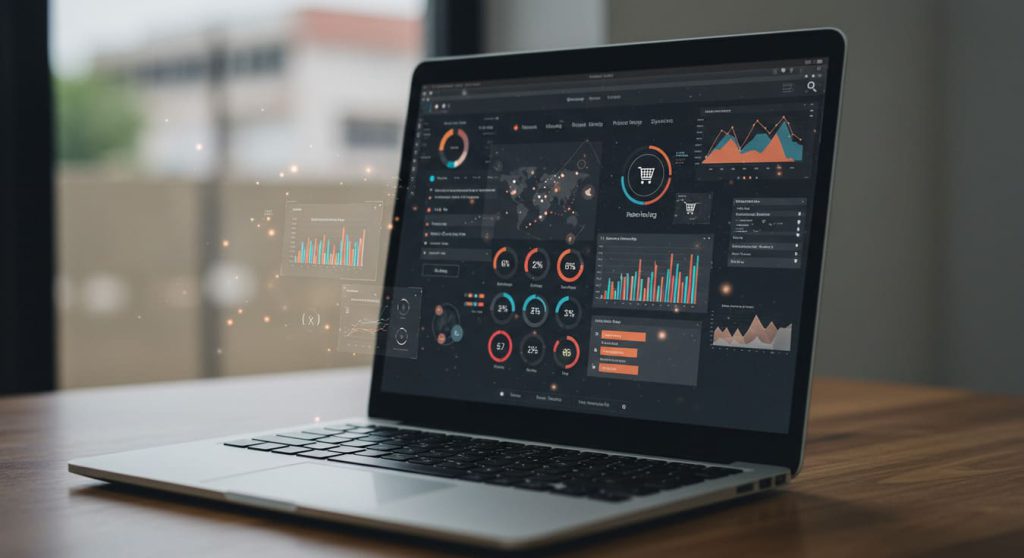Demand Forecasting Best Practices

The difference between a good business and a great one often lies in its ability to predict customer needs before they arise
Why some businesses seem to always have exactly what customers want, while others are constantly apologizing for backorders or slashing prices on overstocked items? The secret isn’t luck—it’s strategic demand forecasting best practices. Most businesses are flying blind when it comes to predicting customer demand.
Table of Contents
✅ Listen to this PODCAST EPISODE here:
Demand Forecasting Best Practices: The Complete Guide
Demand forecasting best practices aren’t complicated, but they require discipline and the right approach. When one of our manufacturing clients in Germany implemented the forecasting framework, they reduced write-offs by 41% while improving customer satisfaction scores by 18 points. The difference between struggling and thriving often comes down to how well you can predict what your customers will want tomorrow.
Core Demand Forecasting Best Practices That Drive Results

The companies excelling at demand forecasting today aren’t just the ones with fancy technology (though that helps). They’re the ones religiously following core demand forecasting best practices that have stood the test of time.
1. Clean, Comprehensive Data Collection
You’ve heard the phrase “garbage in, garbage out.” This is no more true than in demand forecasting.
Establishing robust data collection systems is the most essential of all demand forecasting best practices. This isn’t just about sales numbers—it includes:
- Historical sales data (by product, region, and time period)
- Seasonal variations
- Promotion history and results
- Pricing changes
- External economic indicators
- Competitor activities
- Social media sentiment
- Weather patterns (for weather-sensitive products)
In 2019, we worked with a beverage company that was struggling with forecast accuracy. When our data analytics team dug into their systems, we discovered they were basing forecasts primarily on historical data without factoring in weather forecasts—despite selling products highly sensitive to temperature changes!
After implementing comprehensive data collection that included 5-year weather pattern analysis, their forecast accuracy improved from 67% to 89%. That’s the power of getting your data right.
2. Segment Your Forecasting Approach
Not all products deserve the same forecasting attention or methodology. Effective demand forecasting best practices dictate segmenting your portfolio based on:
- Volume
- Volatility
- Wert
- Lifecycle stage
One of our retail clients spent equal time forecasting their entire 5,000+ SKU catalog. We helped them implement a segmentation approach, applying sophisticated demand forecasting best practices to their top 20% of products (which represented 80% of revenue) while using simpler methods for long-tail items.
The result? Their overall forecast accuracy improved by 23% while reducing the forecasting workload by 40%. Work smarter, not harder.
3. Choose the Right Forecasting Methods
There’s no one-size-fits-all in demand forecasting. Best practices suggest selecting methods based on your specific situation:
For stable products with sufficient history: Time-series methods like exponential smoothing work well.
For new products or volatile demand: Causal methods incorporating external variables often perform better.
For new products: Analogous forecasting using similar products as a baseline can be effective.
4. Implement a Formal Forecast Review Process
This is where so many companies fall short. They create forecasts, but then what? Effective demand forecasting best practices include:
- Regular forecast reviews (weekly for fast-moving items)
- Systematic analysis of forecast errors
- Documented adjustments with rationales
- Continuous model refinement based on performance
Remember, demand forecasting best practices aren’t just about creating the forecast—they’re about how you use, review, and improve it.
Advanced Demand Forecasting Best Practices For Market Leaders

Ready to take your forecasting to the next level? Here’s what the top 5% of companies are doing differently:
1. Incorporate External Data Signals
Leading companies are moving beyond internal data to incorporate external signals like:
- Social media trends
- Search engine data
- Macroeconomic indicators
- Wettbewerbsintelligenz
- Alternative data sources (like satellite imagery of parking lots)
Bei SIS International, we helped an electronics manufacturer integrate Google Trends data into their forecasting models. This single addition improved forecast accuracy for new product launches by 31%—simply by capturing early consumer interest signals that traditional methods missed.
2. Balance Human Judgment and Machine Intelligence
Here’s a controversial opinion: pure statistical forecasting is rarely the answer.
The most effective demand forecasting best practices combine the power of algorithms with structured human judgment. This isn’t about random overrides—it’s about creating a framework where human insights enhance machine predictions.
We call this “forecast triangulation” at SIS, and it’s transformed results for clients across industries. One energy company we work with uses a three-pronged approach:
- Statistical baseline forecast
- Market intelligence adjustments
- Consensus process with weighted inputs
Their forecast accuracy improved from 72% to 91% within 12 months of implementation. The magic happens at the intersection of art and science.
3. Focus on Forecast Value-Add, Not Just Accuracy
Here’s where most companies miss the point entirely: the goal isn’t perfect forecasting. It’s improved business outcomes.
Advanced demand forecasting best practices focus on what we call “Forecast Value-Add” (FVA)—measuring how each step in your process contributes to better business results.
A pharmaceutical client was obsessed with improving forecast accuracy by fractions of a percent until we helped them realize something critical: for many of their products, improving from 85% to 90% accuracy would cost more than the benefits delivered. For others, even modest improvements would deliver millions in savings.
Smart demand forecasting best practices target your efforts where they’ll deliver the most business value.
Implementing Demand Forecasting Best Practices in Your Organization

Demand forecasting best practices are the lifeblood of businesses that consistently outperform their competition.
Ready to transform your forecasting? Here’s your roadmap:
1. Assess Your Current Maturity
Before implementing new demand forecasting best practices, assess where you stand today:
- How are forecasts currently created?
- What data sources do you use?
- How do you measure accuracy?
- What’s the process for review and adjustment?
- How are forecasts integrated with other business processes?
2. Invest in Skills Before Software
Too many companies throw money at expensive forecasting software without addressing the fundamental issue: skill gaps.
Effective demand forecasting best practices require both technical and business knowledge. Before investing in technology, ensure your team understands:
- Statistical concepts
- Data analysis techniques
- Business drivers
- Cross-functional collaboration
When a consumer goods client complained about poor forecast results despite investing in premium software, we discovered their team lacked a fundamental understanding of key forecasting concepts. After a targeted training program on demand forecasting best practices, their accuracy improved by 28% using the same software.
3. Create Cross-Functional Alignment
Successful forecasting isn’t a departmental activity—it’s an enterprise capability.
Implement governance structures that bring together:
- Verkäufe
- Marketing
- Operationen
- Finanzen
- Supply chain
4. Start Small, Scale Fast
Don’t try to transform everything overnight.
Begin by implementing demand forecasting best practices in a limited area—perhaps a single product category or region. Demonstrate success, refine your approach, and then expand.
Key Demand Forecasting Best Practices: Summary

For those of you who like to cut to the chase, here are the crucial takeaways:
✅ Foundation: Establish robust data collection capturing all relevant variables
✅ Segmentierung: Use different approaches for different product types
✅ Methoden: Select forecasting techniques appropriate to your specific needs
✅ Process: Implement formal review processes with clear accountability
✅ External Data: Incorporate outside signals beyond internal sales history
✅ Zusammenarbeit: Balance algorithmic forecasts with structured human input
✅ Value Focus: Target improvements where they deliver the most business value
✅ Skills: Invest in team capabilities before expensive technology
✅ Alignment: Create cross-functional alignment through formal processes
✅ Implementierung: Start small, demonstrate success, and then scale
What Makes SIS International a Top Demand Forecasting Partner?
As business leaders increasingly recognize the competitive advantage of superior demand forecasting, many turn to specialized partners for guidance. Here’s why companies worldwide choose to work with us:
✔ GLOBAL REACH: Our team provides demand forecasting expertise across 120+ countries, helping multinational organizations implement consistent best practices while accounting for regional differences.
✔ 40+ YEARS OF EXPERIENCE: Since 1984, we’ve helped organizations across industries implement demand forecasting best practices through economic cycles, technological revolutions, and market transformations.
✔ GLOBAL DATA BASES FOR RECRUITMENT: Access to 20+ million specialized respondents worldwide allows us to gather unique market intelligence that enhances forecast accuracy beyond typical methods.
✔ IN-COUNTRY STAFF WITH OVER 33 LANGUAGES: Our multicultural team understands the nuances of regional markets, ensuring demand forecasting models account for cultural and market-specific variables often missed by generic approaches.
✔ GLOBAL DATA ANALYTICS: Unser advanced analytics capabilities include proprietary demand forecasting methodologies tested across diverse markets and industries.
✔ AFFORDABLE RESEARCH: We deliver enterprise-level forecasting expertise with flexible engagement models suitable for organizations of all sizes.
✔ CUSTOMIZED APPROACH: Unlike one-size-fits-all forecasting solutions, we tailor demand forecasting best practices to your specific industry challenges and organizational needs.
FAQ: Demand Forecasting Best Practices
How accurate should our demand forecasts be?
This depends entirely on your industry, product characteristics, and forecast horizon. For stable products with long histories, accuracy rates of 80-90% are achievable. For new products or highly volatile categories, 60-70% might be excellent. The better question is: what accuracy level delivers the optimal balance of inventory investment and service level for your specific business?
Should we use AI for demand forecasting?
AI and machine learning can significantly enhance forecasting accuracy—but only when you have the fundamentals right. I’ve seen companies invest millions in AI forecasting only to get worse results than simpler methods because they lacked clean data and proper processes. Start by implementing basic demand forecasting best practices, then selectively apply AI where it can add the most value.
How often should we update our forecasts?
This varies dramatically by industry and product velocity. Fast-moving consumer goods might require weekly or even daily updates, while industrial equipment might use quarterly cycles. The key demand forecasting best practice is alignment with your business rhythm—forecasts should be updated frequently enough to capture significant changes but not so often that you create unnecessary volatility.
How can we improve new product forecasting?
New product forecasting is particularly challenging due to limited historical data. The most effective demand forecasting best practices for new products include:
- Using analogous products as baselines
- Creating structured early market testing programs
- Implementing rapid feedback loops to quickly adjust forecasts
- Utilizing external market signals and expert panels
Should we use multiple forecasting methods?
Absolutely! One of the most powerful demand forecasting best practices is using ensemble forecasting—combining multiple methods to create more robust predictions. Research consistently shows that ensemble forecasts outperform individual methods.
How do we handle forecast bias?
Forecast bias—the tendency to consistently over or under-forecast—is a common challenge. Effective demand forecasting best practices for addressing bias include:
- Implementing formal bias tracking
- Creating accountability for forecast adjustments
- Using statistical correction factors
- Conducting root cause analysis of persistent bias
How should we measure forecasting performance?
Look beyond simple accuracy metrics. Comprehensive demand forecasting best practices include measuring:
- Forecast accuracy (MAPE, RMSE, etc.)
- Bias (direction of errors)
- Volatility (stability of forecasts)
- Business impact (inventory efficiency, service levels, etc.)
Unser Standort in New York
11 E 22nd Street, Floor 2, New York, NY 10010 T: +1(212) 505-6805
Über SIS International
SIS International bietet quantitative, qualitative und strategische Forschung an. Wir liefern Daten, Tools, Strategien, Berichte und Erkenntnisse zur Entscheidungsfindung. Wir führen auch Interviews, Umfragen, Fokusgruppen und andere Methoden und Ansätze der Marktforschung durch. Kontakt für Ihr nächstes Marktforschungsprojekt.


